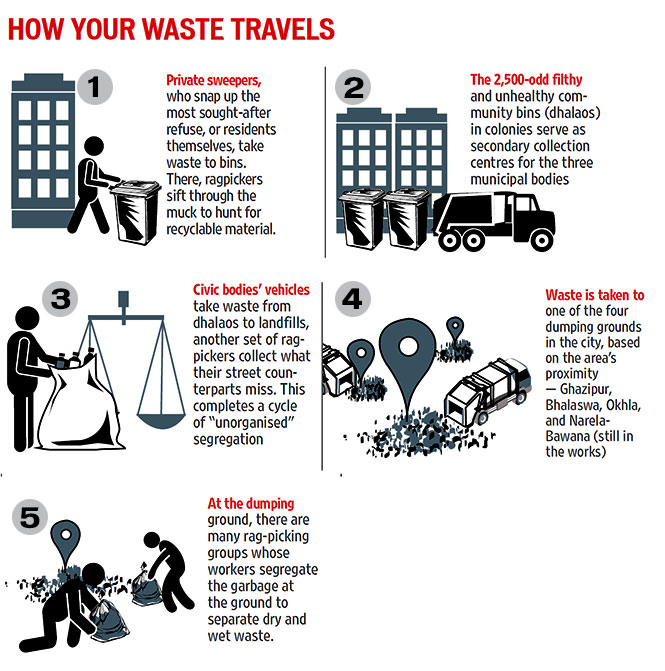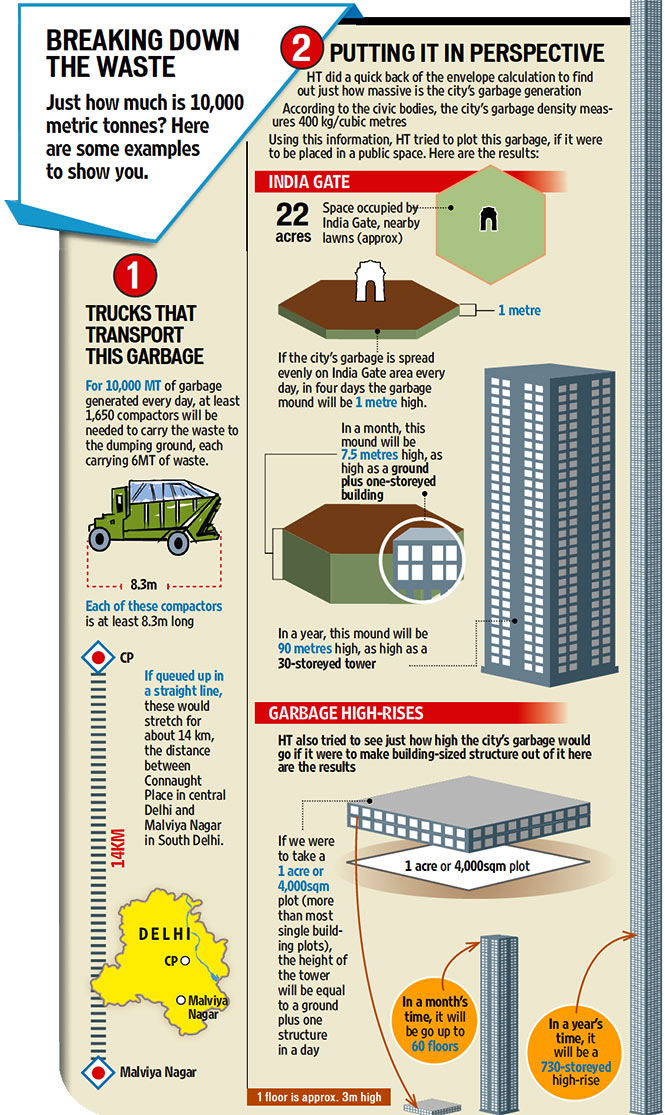Delhi: Garbage crisis reaches tipping point
Delhi’s garbage crisis has reached a tipping point. Three of the four stinking landfills — now virtually mountains of waste — are long overdue for closure and there are no new sites available to absorb the current discard of 10,000 tonnes every day.
Precipitating the crisis, the daily generation of garbage is expected to rise from the current 2,300 trucks to 4,700 trucks by 2024, and Delhi will need an additional area more than the entire spread of Lutyens’ Bungalow Zone to dump its daily waste as early as 2020.
Almost 85% of the city does not have a formal door-to-door trash pickup system and if steps are not taken now, residents will have no option but to start throwing waste out of their doors, community bins (dhalaos) will start overflowing, and only garbage will be seen on the streets — making Delhi drown in its own discards.
Landfills have been especially a problem. Because of poor and unscientific way of maintenance, the waste yards have become massive, polluting and stinking mountains of garbage. This is precisely the reason why people are bitterly opposed to new landfills in their neighbourhood.
The black thick liquid leachate — created when rainwater filters down through the landfill — has made the soil highly toxic. Rainwater runoff goes into surface-water drains and deadly methane is released in the air. More than a dozen landfills have been filled up in Delhi.
Despite court intervention, government and civic agencies have failed to find a way forward. The municipal corporations have now told the Delhi high court that “since there’s no other option, we have been forced to put human life and property at risk”.
Non-dumping options to mange waste have shrunk drastically. Burning waste no longer seems viable because of growing environmental concerns and poor segregation of waste. Compost plants are not doing well because manure doesn’t sell, and again becomes garbage.
The National Green Tribunal (NGT) has told the authorities to introduce waste segregation at source, a move that is likely to reduce pollution and ensure a much cleaner Delhi. People in residential and commercial areas will have to pay ‘an appropriate amount’ for the service, aimed at reducing waste reaching overflowing landfills by 80% through recycling and composting.
As much as 50% of the waste is fit for composting and about 30% of it can be recycled. Effective segregation at source, in transit and during disposal, will mean that only 20 per cent of refuse would be sent to landfills. This means a cleaner city with fewer waste stations, garbage trucks and longer life span for landfills. But even that’s not done properly.
The municipal corporations say residents don’t segregate waste. But residents ask what’s the use when eventually lands up at the same place. Segregation by residents will only work when the corporations have a complete door-to-door waste collection system and trash pickups have separate containers for dry and wet waste.
Experts say the authorities must ensure segregation and promote composting and recycling. They first need to quantify waste generation and study its composition for effective reduction targets.
But the corporations are not the only culprit in this messy story. Citizens who litter without a second thought are equally at fault. People can help in segregation, recycling and composting. While the entire country is following Prime Minister Narendra Modi’s Swachh Bharat Abhiyan, closer home the city’s streets constantly reflect the need for such a drive to take shape urgently.
Bharati Chaturvedi of Chintan Group says: “Wet waste can be easily composted, or turned into bio-gas. To do this, we don’t need more large compost plants, but more and smaller ones, at the ward level. Those who can must start small composting at home. People must start reducing their own packaging. There can be no change without consuming less.”




Precipitating the crisis, the daily generation of garbage is expected to rise from the current 2,300 trucks to 4,700 trucks by 2024, and Delhi will need an additional area more than the entire spread of Lutyens’ Bungalow Zone to dump its daily waste as early as 2020.
Almost 85% of the city does not have a formal door-to-door trash pickup system and if steps are not taken now, residents will have no option but to start throwing waste out of their doors, community bins (dhalaos) will start overflowing, and only garbage will be seen on the streets — making Delhi drown in its own discards.
Landfills have been especially a problem. Because of poor and unscientific way of maintenance, the waste yards have become massive, polluting and stinking mountains of garbage. This is precisely the reason why people are bitterly opposed to new landfills in their neighbourhood.
The black thick liquid leachate — created when rainwater filters down through the landfill — has made the soil highly toxic. Rainwater runoff goes into surface-water drains and deadly methane is released in the air. More than a dozen landfills have been filled up in Delhi.
Despite court intervention, government and civic agencies have failed to find a way forward. The municipal corporations have now told the Delhi high court that “since there’s no other option, we have been forced to put human life and property at risk”.
Non-dumping options to mange waste have shrunk drastically. Burning waste no longer seems viable because of growing environmental concerns and poor segregation of waste. Compost plants are not doing well because manure doesn’t sell, and again becomes garbage.
The National Green Tribunal (NGT) has told the authorities to introduce waste segregation at source, a move that is likely to reduce pollution and ensure a much cleaner Delhi. People in residential and commercial areas will have to pay ‘an appropriate amount’ for the service, aimed at reducing waste reaching overflowing landfills by 80% through recycling and composting.
As much as 50% of the waste is fit for composting and about 30% of it can be recycled. Effective segregation at source, in transit and during disposal, will mean that only 20 per cent of refuse would be sent to landfills. This means a cleaner city with fewer waste stations, garbage trucks and longer life span for landfills. But even that’s not done properly.
The municipal corporations say residents don’t segregate waste. But residents ask what’s the use when eventually lands up at the same place. Segregation by residents will only work when the corporations have a complete door-to-door waste collection system and trash pickups have separate containers for dry and wet waste.
Experts say the authorities must ensure segregation and promote composting and recycling. They first need to quantify waste generation and study its composition for effective reduction targets.
But the corporations are not the only culprit in this messy story. Citizens who litter without a second thought are equally at fault. People can help in segregation, recycling and composting. While the entire country is following Prime Minister Narendra Modi’s Swachh Bharat Abhiyan, closer home the city’s streets constantly reflect the need for such a drive to take shape urgently.
Bharati Chaturvedi of Chintan Group says: “Wet waste can be easily composted, or turned into bio-gas. To do this, we don’t need more large compost plants, but more and smaller ones, at the ward level. Those who can must start small composting at home. People must start reducing their own packaging. There can be no change without consuming less.”




You can return to the main Market News page, or press the Back button on your browser.

